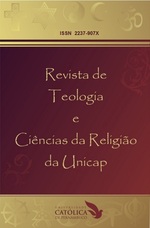O CONCÍLIO DE NICEIA NOS PROTESTATISMOS DO SÉCULO XVI
DOI:
https://doi.org/10.25247/paralellus.2024.v15n37.p495-552Palavras-chave:
Antitrinitarismo, Eclesiologias, Magistério Conciliar, Primado Romano, ProtestantismoResumo
Esta pesquisa apresenta um duplo enfoque e emprega um método estritamente histórico. Na primeira parte, a questão da autoridade dos concílios na igreja, em especial o de Nicéia com o dogma trinitário-cristológico, será analisada no contexto das nascentes e diversas eclesiologias protestantes (1517–1566). Inicialmente, será estudado o desenvolvimento dessa questão no pensamento de Lutero, desde o conflito acerca das indulgências até a controvérsia eclesiológica sobre a autoridade dos concílios, com atenção especial à natureza e à relevância atribuída ao Concílio de Nicéia, segundo o qual até mesmo o papa deveria submeter-se aos Decretos de Fé estabelecidos por um concílio universal (1517–1521). Na sequência, serão apresentadas as posições oficiais dos principais protagonistas da Reforma—Melanchthon, Lutero, Calvino e líderes da Igreja Reformada Suíça—em seus escritos oficiais entre 1530 e 1566, abordando o tema da autoridade dos concílios universais, com destaque para Nicéia, no embate com os defensores da “primazia romana” e com as correntes evangélicas antitrinitárias (1530–1566). Na segunda parte, serão analisadas, com metodologia histórica, as diversas correntes radicais e antitrinitárias da Europa “protestante” do século XVI que se opuseram ao dogma de Nicéia, como os anabatistas de Estrasburgo, Miguel Serveto, Johann Campanus, Giorgio Biandrata, Lelio e Fausto Sozzini, Matteo Gribaldi, Giorgio Rioli e Valentino Gentile. Também será abordada a luta, muitas vezes violenta, conduzida pelos líderes protestantes “ortodoxos” em defesa da verdade dogmática da Trindade e da cristologia nicena.
Downloads
Referências
O. H. PESCH, Martin Lutero. Introduzione storica e teologica, (ed. ted. 2004) Brescia 2007, pp.125-126.
LUTERO, Resolutiones disputationum de indulgentiarum virtute, WA 1, (522) 525-608; tr. it. in LOS
, 49-437 a cura di RICCA, ivi compresa le lettere a Staupitz (ivi, pp. 32-39) e a Leone X (ivi, pp. 39-45), Claudiana, Torino 2013.7
K. V. SELGE, La chiesa in Lutero, in AA. VV., Martin Lutero, Ed. Vita e pensiero, Milano 1984, p. 17.
LUTERO, Ad dialogum Silvestri Prieratis de potestate papae responsio, 1518, WA 1, (644) 647-686.
Downloads
Publicado
Edição
Seção
Licença
Copyright (c) 2024 Stefano Cavallotto

Este trabalho está licenciado sob uma licença Creative Commons Attribution 4.0 International License.
A submissão de originais para a Paralellus implica a transferência, pelos autores, dos direitos de publicação eletrônica. Os direitos autorais para os artigos veiculados neste periódico são do autor; todavia, são da revista os direitos sobre a primeira publicação. Os autores somente poderão fazer uso dos mesmos resultados em outras publicações se indicarem, claramente, que a Paralellus foi o meio originalmente utilizado. Em decorrência do fato de ser a Paralellus uma revista de acesso público, é permitida a utilização gratuita dos artigos em aplicações educacionais e/ou científicas não comerciais, desde que respeitando-se a exigência de citação da fonte (Texto atualizado em 16-11-2020).


















